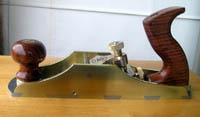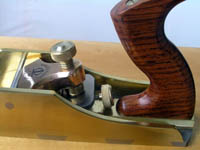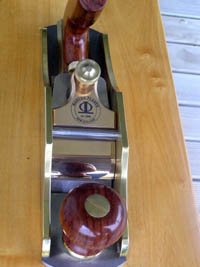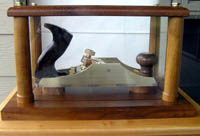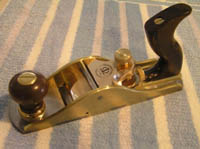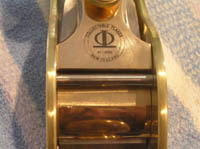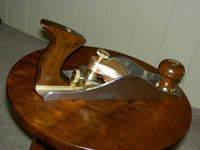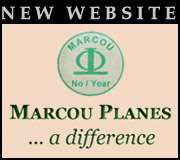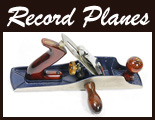Interview With Plane Maker Philip Marcou
Many woodworkers are aware of the more well known contemporary planemakers such as Tom Lie-Nielsen, John Economaki and Karl Holtey – but what about the makers who are just starting out? Will some of these be added to the list of household names (amongst woodworkers) in the coming years? Why do they make planes, how do they make planes and where did they learn to make planes in the first place?
Philip Marcou is a new maker who makes beautifully crafted hand planes modeled, stylistically, on Stanley Bedrocks, but injected with his own innovations, ideas and methods incorporated within the designs. In his native country of Zimbabwe Philip was a professional cabinet maker, running his own woodworking business for 12 years. His work was highly sought after and Philip earned a reputation with the German Embassy for making finely-crafted furniture.
A number of years ago Philip emigrated from Zimbabwe to New Zealand, taking all of his woodworking tools and machinery, along with some of his country’s native timbers and some exotic hardwoods from the Americas. He continues to make furniture, but now also makes high-quality woodworking planes on the side. Handplane Central talks to Philip about his plane making and gets a few surprising answers.
H.C. – How did you get involved in making hand planes?
Philip Marcou – I got involved with making handplanes when I bought a Veritas #62-1/2 and a 4-1/2 smoother. There were things that I modified, such as the handles and the means of fixing the knob and cap. I liked the way the bevel-up blade on the 62-1/2 worked, and this prompted me to make a smoother plane using double dovetails.
H.C. – Was it difficult getting information on making planes? What were your main sources?
Philip Marcou – Since making that first plane , gathering information from the internet has been easy. I also have many woodworking books. Also the Knots forum at Fine WoodWorking has been instructive in determining what is the “flavour of the month”.
I’ve tried to stay away from gazing at the web sites of other plane makers because I want to develop my own style. At the same time, as a professional cabinet maker, I would like to see certain characteristics in these planes, so my designs hopefully will reflect this.
H.C. – How difficult was the transition between wanting to make a plane and actually making one? Did you find that you procrastinated for a while, or did you just jump in and do it?
Philip Marcou – There was no difficulty involved in the transition from the idea to putting it into practice. Basically whenever I have what I think may be a good idea I tend to think on it for some time, visualising the thing and working out how to make it reality – a form of constructive procrastination.
H.C. – Did you have a mentor, or someone who you looked up to for inspiration and/or direction?
Philip Marcou – At the time of making that first plane I knew of hardly any plane makers, let alone their web sites. I had seen Norris type planes in the flesh, but only pictures of dovetailed planes. From knifemaking experience I know that the combination of fine wood , brass and steel is a seductive one.
Since seeing Karl Holtey’s web site this is where I would like to be at. I have shown him pictures of my work and intend to liase with him in the future.
H.C. – Rather than modeling your planes on British infills you’ve followed the American makers. Are there particular reasons for this?
Philip Marcou – I’m not sure that I have modeled my planes on any in particular, apart from the Veritas influence. I wanted to go the bevel-up way, the Veritas blade was available and suited my intentions. Also British infills are omni-present, I am trying to make something unusual, but practical (and good looking). In my mind the thing must work well, look good and be well made/have good workmanship qualities. If I now see features in other planes that I can improve upon and embody in my planes that is what I want to do.
H.C. – What materials do you use for your planes?
Philip Marcou – At the moment I use gauge plate for the sole, because it is obtainable in accurately ground stock. I do not at present have a surface grinder. if I had I would probably be using hot rolled bright mild steel for the soles. I have not investigated stainless yet.
I use brass plate for the sides. This is the cartridge brass type alloy which is good for peining. Brass for the bed and knobs , bronze for the cap, tool steel for the knob stud and cross bar and adjuster stem. Stainless machine screws for fixing bed etc. I avoid re-cycled materials, especially brass, as one is then not sure of what one is getting.
For the wood I like to use Imbuia when it has dark figured grain, Rhodesian Teak, Afromozia, Muninga, and would like to get one or two New Zealand woods.
H.C. – Is it difficult or costly to get materials?
Philip Marcou – Materials in New Zealand are expensive, but generally speaking not too hard to find.
H.C. – You dovetail your plates together in the manner of British infill planes. Do you use machines to cut the dovetails or do you do this by hand?
Philip Marcou – I am definitely not of the hammer hacksaw file and shifting spanner brigade. I have two smallish metal lathes, one of which has a milling head attached- it is the Emco Super Eleven. I also have a crude milldrill which is good for roughing out. I avoid hacksaws and files as much as possible. I have a small bandsaw which I have pullied down to speeds suitable for cutting brass and bronze, the same saw driven via a reduction gear box also cuts steels. It is a woodworking bandsaw but so far has been able to withstand the extra tensions required for metal cutting. So I cut dovetails using mainly the Emco mill and the bandsaw which allows me to retain the classic look rather than those cnc type dovetails.I still have to file the flair on the sockets by hand.
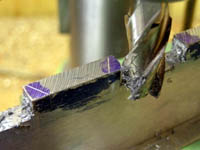
Other machines are my antique South Bend lathe and home made belt grinder (not belt sander), my disk sander on the outboard of my Wadkin lathe and an adapted edge sander.
I have spent a lot of time making small tools and mods specifically to help with plane making. There is also the need to see more acutely so I found that a head loupe to be useful. My favourite measuring instrument is the digital caliper and I made a base that attaches to the stem, facilitating accurate depth measurement. I enjoy good quality tools.
H.C. – Your dovetails are set at rather steep angles. Any particular reason for this?
Philip Marcou – I use a standard 30° dovetail cutter in the milling machine so that is where the “steep” angle comes from: that is fortunate, because that is the look I want. The other flare is the one I have to do by hand, and I use 5° for this as it would be hard to pein anything much greater than that.
H.C. – Did you have any difficulty peening the dovetails? Any tips or tricks that you’ve picked up?
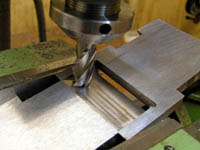
Philip Marcou – No difficulty with peining. As for tips, use a suitable hammer and a wrist movement – without trying to hit too hard. It should be a taptapping method. I also use a punch with the end shaped to pein the brass. Make sure to clamp each set as you pein them.
H.C. – Do you make your own adjusters?
Philip Marcou – I make my own adjusters and avoid as much outwork as possible. In fact the only outwork is the surface grinding and the laser engraving of the motif.
H.C. – What blades do you use for your planes. Do you make them yourself or use aftermarket blades?
Philip Marcou – I use the Veritas A2 bevel up blades. I have some stock of D2 from my knife making days and plan to use this for other plane designs in the cerebral melting pot as it is a super steel and close by here there is an engineering company capable of doing the required heat treatment consistently.
H.C. – Explain how you get your maker’s mark on your planes, and what the mark symbolizes?
Philip Marcou – The logo is the Greek letter “PHI” which symbolises purity and balance and I am of Greek extract anyway. It is done by laser engraving machine.
H.C. – How many planes have you made? What kinds of planes were they?
Philip Marcou – I have only made six planes – all smoothers – but intend to make many more.
H.C. – Do you see yourself possibly becoming a commercial maker later down the track, even if it’s only a dozen or so planes a year?
Philip Marcou – I intend to become a commercial maker of note – not a volume maker, but a quality custom maker. This is re-inforced by the fact that quality woodworking in New Zealand is not well received. in the words of Karl Holtey “they are not ready for it”.
H.C. – What do you think of the internet as a planemaking resource? Do you feel that websites and forums can provide more detailed or up to date information than that which can be found in more traditional media such as books and magazines?
Philip Marcou – The internet is an invaluable plane making resource-far more flexible and up to date than books and magazines. Books are good for reference purposes though.
H.C. – What’s next on the agenda? What planes are you interested in making? What ideas do you want to incorporate?
Philip Marcou – I have to make some more smoothers in anticipation of some initial orders. The three that I am about to complete are all taken up.
I intend to make a type of plane that is quicker to produce, same quality but cheaper. It could, alternatively, have dovetails for the “elite” version. The plane is actually sitting completed “in my head” at the moment so I am itching to do it.
I’m also interested in making practical useful planes of lasting value and good appearance, so ornaments are out unless a customer wants to pay for it.
To see some of Philip’s planes check out the Marcou Planes website. To have a look at some of Philip’s other work then click here to go to his woodworking site.

